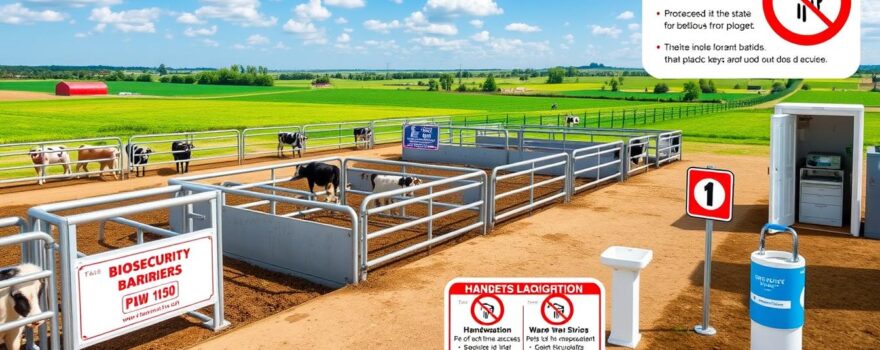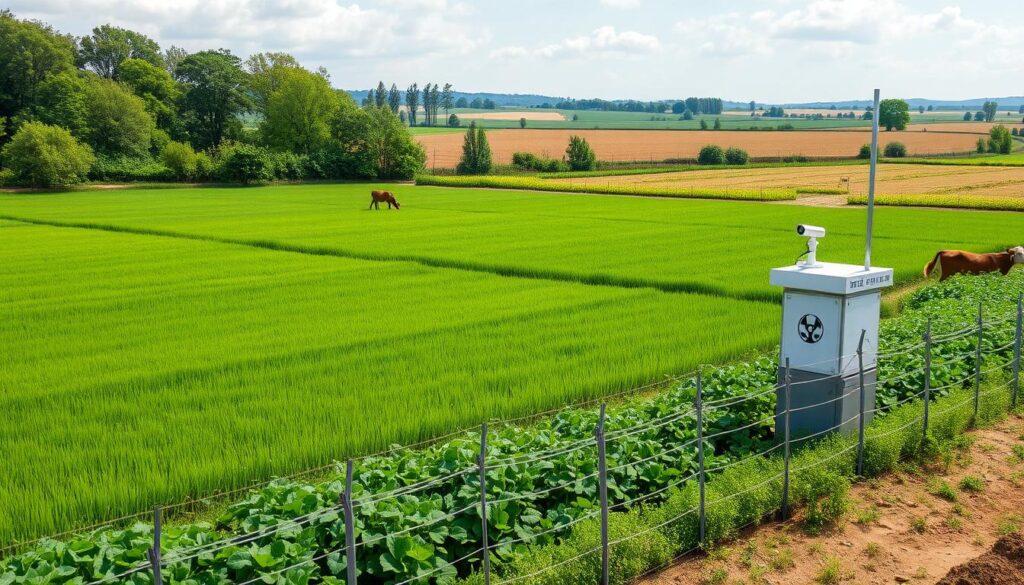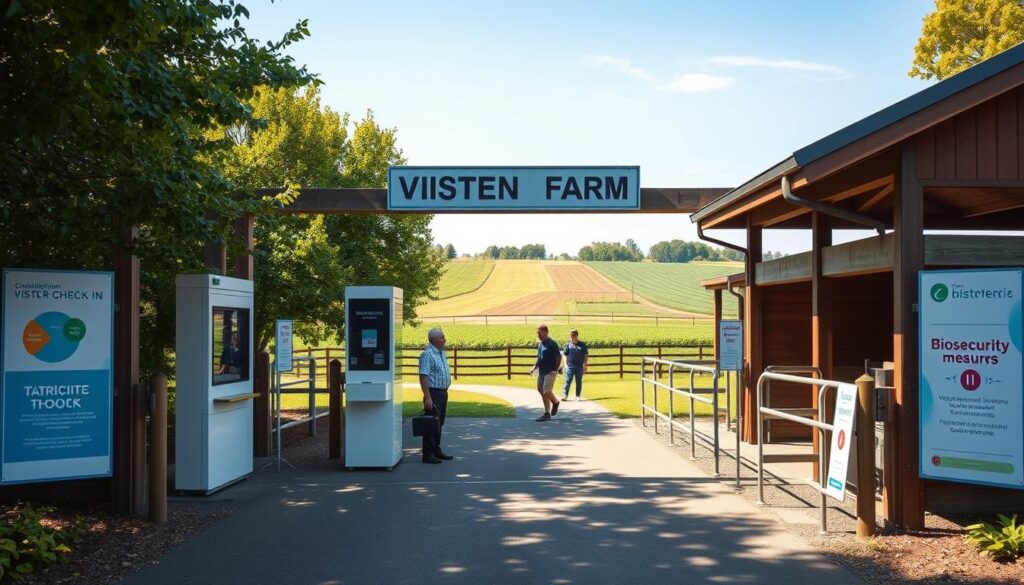
Keeping your farm safe from diseases is key to success. This guide will show you how to keep your farm safe. By following these steps, you can protect your animals, meet rules, and make your farm better.
Key Takeaways
- Understand the importance of farm biosecurity and the potential impacts on animal health and productivity
- Learn how to monitor and improve biosecurity compliance on your farm through comprehensive planning and auditing processes
- Discover effective disease prevention strategies, including vaccination programs and quarantine procedures
- Implement best practices for animal health monitoring, farm hygiene, and visitor management
- Develop employee training and compliance programs to ensure consistent biosecurity implementation
The Importance of Farm Biosecurity
Keeping your farm safe from diseases is key. Farm biosecurity helps protect your animals and crops. It involves many steps to reduce biosecurity risks and keep your farm healthy and productive.
Understanding Biosecurity Risks
Farmers deal with many biosecurity risks. These include bringing in diseases with new animals or equipment. Visitors and wildlife can also spread diseases. Ignoring these risks can harm your animals and farm work.
Potential Impacts on Animal Health and Productivity
Diseases can badly hurt animal health. They can make animals sick, lower yields, and even cause death. This can hurt your farm’s work and money, making good biosecurity very important.
Knowing about farm biosecurity and biosecurity risks helps farmers. They can take steps to protect their animals, crops, and farm. This keeps animals healthy and boosts farm work.
How to Monitor and Improve Biosecurity Compliance on Your Farm
Keeping your farm safe from diseases is key to healthy animals and good farm work. To do this, you need a solid plan for checking and improving biosecurity. Here are the main steps to follow:
Develop a Detailed Biosecurity Plan
First, make a detailed biosecurity plan. It should cover all important steps and rules for your farm. Make sure it includes who does what and how to follow the rules.
Conduct Regular Biosecurity Audits
Check your farm’s biosecurity often to find what needs work. Do both inside and outside checks to see how well things are going.
| Audit Type | Frequency | Key Focuses |
|---|---|---|
| Internal Audit | Quarterly |
|
| External Audit | Annually |
|
With a strict audit plan, you can keep your farm safe and make it even better.
Having a strong farm biosecurity compliance program is vital. It keeps your animals healthy and your farm running well. Follow these steps to make your farm safer and more reliable.
Developing a Comprehensive Biosecurity Plan
Creating a strong farm biosecurity plan is key to keeping your farm safe and healthy. It involves finding critical control points and setting up clear standard operating procedures. This ensures biosecurity is followed everywhere on the farm.
Identifying Critical Control Points
The first step is to find the critical control points on your farm. These are areas or activities that could bring in diseases. By looking at your farm’s layout and operations, you can spot these high-risk spots.
Establishing Standard Operating Procedures
After finding the critical control points, you need to create detailed standard operating procedures (SOPs). These SOPs should cover things like animal care, cleaning vehicles and equipment, managing visitors, and handling waste. Standardizing these steps helps keep your farm safe from diseases.
Having a solid farm biosecurity plan with clear critical control points and standard operating procedures is a smart move. It protects your animals’ health and keeps your farm running well. By focusing on these areas, you can make your farm safer for your livestock.
“Implementing a comprehensive biosecurity plan is a crucial investment in the long-term health and success of your farm.”
Farm Biosecurity Protocols
Keeping your farm safe from diseases is key. Farm biosecurity protocols help protect your animals’ health and farm success. These biosecurity measures stop diseases from spreading.
Cleaning and disinfecting is a big part of keeping your farm safe. You should clean all equipment, vehicles, and places where animals live. This stops diseases from spreading.
Managing how animals move around is also important. Make sure new animals are checked before they join your herd. Watch who comes and goes to keep diseases out.
It’s also vital to keep feed and water clean. Test and treat water, and buy feed from trusted sources. This stops harmful things from getting into your animals’ food and water.
Following strict farm biosecurity protocols helps keep your farm healthy. This keeps your animals safe and your farm running well.
“Effective farm biosecurity protocols are the foundation of a thriving and resilient agricultural operation.”
Biosecurity Audits and Monitoring
Keeping your farm safe from disease is an ongoing task. Regular checks and monitoring are key to success. By doing both internal and external audits, you can spot and fix weak spots in your biosecurity.
Internal Biosecurity Audits
Internal audits let you check how well your biosecurity plans work. They help you find and fix any problems early. You can look at things like how well your staff is trained, how clean your equipment and facilities are, and how you manage visitors.
External Biosecurity Audits
It’s also smart to get outside help for biosecurity checks. Experts can spot things you might miss. They’ll look at your whole biosecurity plan, including how you keep an eye on things, and suggest ways to get better.
By doing both internal and external audits, you get a clear picture of your farm’s safety. This helps you keep your animals healthy and your farm running well.
“Regular biosecurity audits and monitoring are critical for maintaining the highest levels of biosecurity on your farm. These assessments help identify areas for improvement and ensure that your protocols are being effectively implemented.”
Disease Prevention Strategies
Effective disease prevention is key to a strong farm biosecurity program. By using comprehensive vaccination programs and strict quarantine and isolation, farmers can lower disease outbreak risks. This helps keep their farms healthy.
Vaccination Programs
Vaccination is crucial for disease prevention. A detailed vaccination schedule for your livestock protects against many diseases. Regular vaccinations keep your animals healthy and prevent disease spread to other farms.
Quarantine and Isolation Procedures
Strong quarantine and isolation rules are vital to stop disease spread. New animals must go through a quarantine period to check their health. Sick animals should be isolated quickly to protect the rest of the herd.
Combining vaccination programs with strict quarantine and isolation boosts disease prevention. This keeps your farm healthy and productive.

“Proactive disease prevention is the most effective way to protect the health and well-being of your livestock.”
Animal Health Monitoring and Record-Keeping
Keeping a strong biosecurity program on your farm means watching animal health closely and keeping detailed records. It’s important to watch your animals for any signs of sickness early. This helps catch problems fast.
By watching how your animals act, eat, and look, you can spot health issues early. This helps keep your herd healthy and supports your biosecurity compliance efforts.
Keeping good records is key to animal health monitoring. You should write down all vet visits, shots, deaths, and other health info. This helps you understand your herd’s health better.
These records are also important when auditors come. They show you’re serious about record-keeping and follow biosecurity rules.
“Proactive animal health monitoring and thorough record-keeping are the cornerstones of a robust biosecurity program on any modern farm.”
By making animal health monitoring and record-keeping part of your daily work, you can prevent diseases. This keeps your herd productive and your farm in line with biosecurity laws.
Farm Hygiene and Sanitation Practices
Keeping your farm clean and following strict sanitation rules is key to biosecurity. Good cleaning and disinfection methods help stop diseases from spreading. This keeps your animals healthy and productive.
Cleaning and Disinfection Protocols
Having a solid cleaning and disinfection plan is vital for farm hygiene and sanitation practices. This means:
- Regularly cleaning and disinfecting all surfaces, equipment, and facilities on the farm.
- Using approved, broad-spectrum disinfectants that kill many pathogens.
- Having strict foot and vehicle disinfection at all entry and exit points.
- Properly storing, handling, and disposing of cleaning and disinfection supplies.
- Keeping detailed records of all cleaning and disinfection activities to show compliance.
Following these sanitation practices greatly lowers disease risk. This protects the health and productivity of your farm.
“Effective farm hygiene and sanitation practices are the foundation of a robust biosecurity program.”
It’s important to regularly check and update your cleaning and disinfection protocols. This keeps your farm’s biosecurity high.
Visitor Management Systems
Effective visitor management systems are key to a strong farm biosecurity program. They help prevent diseases from entering your farm. By controlling who comes in, requiring protective gear, and keeping visitor records, you protect your animals and farm.
One important part of visitor management is access control. Setting clear rules for who can enter and when helps keep diseases out. This might mean limiting where visitors go or using a system to track their movements.
Another crucial step is making visitors wear personal protective equipment (PPE). Giving them special clothes and shoes helps stop diseases from spreading. Having a ready supply of PPE shows you’re serious about keeping your farm safe.
Keeping visitor logs is also vital. Recording who visits, when, and where they go helps track diseases. This info is crucial if a disease breaks out.
| Visitor Management Strategies | Benefits |
|---|---|
| Access Control | Restricts potential disease vectors, protects biosecure zones |
| Personal Protective Equipment (PPE) | Prevents the introduction and spread of pathogens |
| Visitor Log-Keeping | Aids in disease tracing and outbreak investigations |
By using a good visitor management system, you boost your farm’s biosecurity compliance and disease prevention. This keeps your animals healthy and productive.

Employee Training and Compliance Programs
Keeping your farm safe and disease-free is key. Employee training is a big part of this. Good employee training programs help with biosecurity compliance, disease prevention, and farm safety. They teach your team how to keep your farm safe and healthy.
Good employee training covers important topics. These include:
- Proper biosecurity protocols and procedures
- Identifying and reporting disease symptoms
- How to clean and disinfect
- Using personal protective equipment (PPE)
- Managing visitors and keeping the farm safe
It’s important to have regular training. Hands-on practice and constant reminders help keep everyone on the same page. This way, your team can spot and stop risks. It keeps your animals healthy and productive.
| Training Topic | Frequency | Responsible Party |
|---|---|---|
| Biosecurity Protocols | Quarterly | Farm Manager |
| Disease Identification | Bi-annual | Veterinarian |
| Cleaning and Disinfection | Monthly | Sanitation Supervisor |
| PPE Usage | Quarterly | Safety Officer |
| Visitor Management | Bi-annual | Biosecurity Coordinator |
With solid employee training and a focus on biosecurity compliance, you can lower disease risks. This makes your farm safer and more productive.
Monitoring and improving biosecurity is key for modern farms. A strong farm biosecurity plan, regular audits, and employee training are crucial. These steps help prevent disease, keep animals healthy, and follow regulatory compliance.
High biosecurity compliance levels protect livestock and the farm’s future. Proactive disease prevention and ongoing monitoring are essential. This way, farmers can avoid big problems and keep their farms thriving.
By focusing on farm biosecurity, farmers make their operations stronger and more productive. This also helps with food security and taking care of the environment. As farming evolves, sticking to biosecurity best practices will always be important.